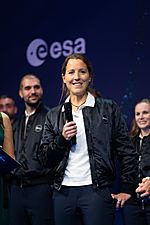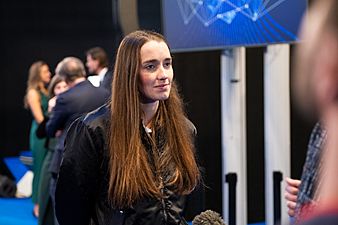2022 European Space Agency Astronaut Group facts for kids
Quick facts for kids  |
|
| Year selected | 2022 |
|---|---|
| Number selected | 5 Career, 11 Reserve, 1 Parastronaut |
The 2022 European Space Agency Astronaut Group is the newest team of astronauts chosen by the European Space Agency (ESA). This group includes five "career" astronauts, who will work full-time for ESA. It also has eleven "reserve" astronauts and one "parastronaut," who has a physical disability. This was ESA's fourth time looking for new astronauts, and the first time since 2008. More than 22,000 people applied to join this exciting program!
These new astronauts will join others chosen in 2009. They will fly on long missions to the International Space Station (ISS). They are also expected to be part of the crews heading to the Moon in the late 2020s and through the 2030s. These Moon missions are part of the Artemis program, which aims to send humans back to the Moon.
Contents
Meet the New Astronauts: The 2022 Group
The names of the chosen astronauts were announced in Paris on November 23, 2022. This happened at the end of a big meeting for ESA.
Besides the five "career astronauts," ESA also picked a "reserve pool" of astronauts. These reserve astronauts will not work for ESA all the time. However, they might get the chance to fly on special missions later. ESA also started a special project to find people with physical disabilities who could become astronauts. This "parastronaut feasibility project" aims to see if they can fly to space, though it's not a guarantee.
- Career astronauts
-
Sophie Adenot

Sophie is a helicopter test pilot. -
Rosemary Coogan

Rosemary is an astrophysicist.
Parastronaut
- John McFall
 John is an orthopaedic surgeon.
John is an orthopaedic surgeon.
Reserve Astronauts
- Meganne Christian
 Meganne is a materials scientist.
Meganne is a materials scientist. - Anthea Comellini
 Anthea is an aerospace engineer.
Anthea is an aerospace engineer. - Sara García Alonso
 Sara is a biomedical scientist.
Sara is a biomedical scientist. - Andrea Patassa
 Andrea is a test pilot.
Andrea is a test pilot. - Carmen Possnig
 Carmen is a medical doctor.
Carmen is a medical doctor. - Arnaud Prost
 Arnaud is a flight test engineer.
Arnaud is a flight test engineer. - Amelie Schoenenwald
 Amelie is an immunologist.
Amelie is an immunologist. - Aleš Svoboda
 Aleš is a fighter pilot.
Aleš is a fighter pilot. - Sławosz Uznański
 Sławosz is a radiation effects engineer.
Sławosz is a radiation effects engineer. - Marcus Wandt
 Marcus is a test pilot.
Marcus is a test pilot. - Nicola Winter
 Nicola is a fighter pilot.
Nicola is a fighter pilot.
How Astronauts Are Chosen: The Recruitment Process
ESA announced they were looking for new astronauts in February 2021. People could apply between March 31 and June 18 of that year. The deadline was moved back because Lithuania joined ESA. This meant citizens from Lithuania could also apply.
What You Need to Be an Astronaut
To apply, you had to be a citizen of an ESA member country. You also had to be under 50 years old. Your height needed to be between 150 and 190 centimeters. ESA especially wanted more women to apply. This was to help close the gap between male and female astronauts.
Other important things included:
- Being good at English and another language.
- Having a master's degree in science, medicine, engineering, or math.
- Or, being an experimental test pilot.
- Having good hearing and a pilot's medical certificate.
If chosen, astronauts get special training. This includes learning survival skills and the Russian language. They also learn about robotics, how to navigate in space, and how to do spacewalks.
For the parastronaut program, ESA looked for people with certain physical disabilities. This included people with missing lower limbs or different leg lengths.
Who Applied to Be an Astronaut
ESA received 22,523 applications in total. About 257 people applied for the parastronaut program. This was a lot more applications than the last time ESA looked for astronauts.
About 24% of the applicants were women. This was a big increase from the previous selection. France had the most applicants, with over 7,000 people applying. This might be because French astronaut Thomas Pesquet was on the International Space Station when applications were open.
| Austria |
Belgium |
Czech Republic |
Denmark |
Estonia |
|---|---|---|---|---|
| 466 (24.9%) | 1007 (22.8%) | 204 (18.1%) | 145 (24.1%) | 57 (38.6%) |
| Finland |
France |
Germany |
Greece |
Hungary |
| 308 (18.8%) | 7087 (23.2%) | 3695 (28%) | 281 (21.4%) | 149 (22.8%) |
| Ireland |
Italy |
Latvia |
Lithuania |
Luxembourg |
| 276 (28.3%) | 1845 (18.8%) | 83 (27.7%) | 80 (23.8%) | 64 (18.8%) |
| The Netherlands |
Norway |
Poland |
Portugal |
Romania |
| 982 (30.1%) | 391 (17.9%) | 549 (23.3%) | 320 (19.1%) | 254 (21.7%) |
| Slovenia |
Spain |
Sweden |
Switzerland |
United Kingdom |
| 62 (21%) | 1341 (22.2%) | 281 (18.1%) | 668 (17.8%) | 2000 (28.5%) |
The Astronaut Selection Stages
The selection process had six main steps:
- Screening: ESA checked all the application forms and documents. About 1,361 astronaut candidates and 27 parastronaut candidates moved to the next stage.
- Initial Tests: People took tests to check their thinking skills, technical knowledge, and how well they could coordinate movements. They also took personality tests.
- Assessment Centre: Candidates did more tests, including group activities and practical tasks.
- Medical Tests: Doctors checked their physical and mental health. This was to make sure they could handle long space missions.
- Panel Interview: Candidates had interviews to show their skills and how they behave. ESA also did a background check.
- Final Interview: The last step was an interview with the head of the European Space Agency in Paris.
| Stage | Applicants
(of which para.) |
Completed | %♀ | % of previous | Ref. |
|---|---|---|---|---|---|
| Screening | 22,780 (257) | June 2021 | 24% | – | |
| Initial tests | 1,388 (27) | March 2022 | 39% | 5.9% | |
| Assessment centre | ~400 | May | ~28.8% | ||
| Medical tests | June | ~25% | |||
| Panel interview | |||||
| Final interview | October | 40%+ | |||
| Confirmed | 23 November 2022 | ||||
| Astronauts | 5 | 40% | |||
| Reserve pool | 11 | 54% | |||
| Parastronauts | 1 | 0% | |||
See also
- NASA Astronaut Group 23






